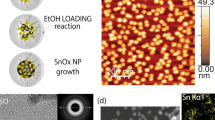Abstract
Optimizing efficiencies of organic light-emitting diodes (OLEDs) with a structure of Al/glass/nanometer-thick polycrystalline p-Si (NPPS) anode/SiO2/N′-bis-(1-naphthl)-diphenyl-1,1′-biphenyl-4,4′-diamine (NPB)/tris (8-hydroxyquinoline) aluminum (Alq3)/4,7-diphenyl-1,10-phenanthroline (BPhen):Cs2CO3/Sm/Au were studied. The NPPS anodes were fabricated by magnetron sputtering (MS) Si and Ni layers followed by Ni-induced crystallization of the amorphous Si layers. By adjusting the resistivity of the p-Si target adopted in MS, the electroluminescent efficiency of the OLED was optimized. When the resistivity of the p-Si target is 0.01 Ω·cm, the current and power efficiencies of the NPPS anode OLED reach maximum values of 6.7 cd·A−1 and 4.64 lm·W−1, respectively, which are 2.7 and 3.1 times those of the resistivity-optimized bulk p-Si anode counterpart and 2.9 and 3.7 times those of the indium tin oxide (ITO) anode counterpart, and then, the physical reasons were discussed.




Similar content being viewed by others
References
Burrows PE, Gu G, Bulović V, Shen Z, Forrest SR, Thompson ME. Achieving full-color organic light-emitting devices for lightweight, flat-panel displays. IEEE Trans Electron Devices. 1997;44(8):1188.
Xiao LX, Chen ZJ, Qu B, Luo JX, Kong S, Gong QH, Kido JJ. Recent progresses on materials for electrophosphorescent organic light-emitting devices. Adv Mater. 2011;23(8):926.
Kim H, Pique A, Horwitz JS, Mattoussi H, Murata H, Kafafi ZH, Chrisey DB. Indium tin oxide thin films for organic light-emitting devices. Appl Phys Lett. 1999;74(23):3444.
Cui J, Wang AC, Edleman NL, Ni J, Lee P, Armstrong NR, Marks TJ. Indium tin oxide alternatives-high work function transparent conducting oxides as anodes for organic light-emitting diodes. Adv Mater. 2001;13(19):1476.
Schlatmann AR, Floet DW, Hillberer A, Garten F, Smulders PJM, Klapwijk TM, Hadziioannou G. Indium contamination from the indium–tin–oxide electrode in polymer light-emitting diodes. Appl Phys Lett. 1996;69(12):1764.
Scott JC, Kaufman JH, Brock PJ, Dipietro R, Salem J, Goitia JA. Degradation and failure of MEH-PPV light-emitting diodes. J Appl Phys. 1996;79(5):2745.
Philips JM, Kwo J, Thomas GA, Carter SA, Cava RJ, Hou SY, Krajewski JJ, Marshall JH, Peck WF, Rapkine DH, Dover RBV. Transparent conducting thin films of GalnO3. Appl Phys Lett. 1994;65(1):115.
Ni J, Yan H, Wang AC, Yang Y, Stern CL, Metz AW, Jin S, Wang L, Marks TJ, Ireland JR, Kannewurf CR. MOCVD-derived highly transparent, conductive zinc- and tin-doped indium oxide thin films: precursor synthesis, metastable phase film growth and characterization, and application as anodes in polymer light-emitting diodes. J Am Chem Soc. 2005;127(15):5613.
Li JF, Hu LB, Wang L, Zhou YX, Grüner G, Marks TJ. Organic light-emitting diodes having carbon nanotube anodes. Nano Lett. 2006;6(11):2472.
Kim H, Horwitz JS, Kim WH, Makinen AJ, Kafafi ZH, Chrisey DB. Doped ZnO thin films as anode materials for organic light-emitting diodes. Thin Solid Films. 2002;420:539.
Chen CW, Hsieh PY, Chiang HH, Lin CL, Wu HM, Wu CC. Top-emitting organic light-emitting devices using surface-modified Ag anode. Appl Phys Lett. 2003;83(25):5127.
Zhang DH, Ryu KM, Liu XL, Polikarpov E, Ly J, Tompson ME, Zhou CW. Transparent, conductive, and flexible carbon nanotube films and their application in organic light-emitting diodes. Nano Lett. 2006;6(9):1880.
Gruner G. Carbon nanotube films for transparent and plastic electronics. J Mater Chem. 2006;16(35):3533.
Wu JB, Agrawal M, Becerril HA, Bao ZN, Liu ZF, Chen YS, Peumans P. Organic light-emitting diodes on solution-processed graphene transparent electrodes. ACS Nano. 2010;4(1):43.
Sun T, Wang ZL, Shi ZJ, Ran GZ, Xu WJ, Wang ZY, Li YZ, Dai L, Qin GG. Multilayered graphene used as anode of organic light emitting devices. Appl Phys Lett. 2010;96(13):133301.
Han TH, Lee Y, Choi MR, Woo SH, Bae SH, Hong BH, Ahn JH, Lee TW. Extremely efficient flexible organic light-emitting diodes with modified graphene anode. Nat Photonics. 2012;6(2):105.
Meng H, Dai Y, Ye Y, Luo JX, Shi ZJ, Dai L, Qin GG. Bilayer graphene anode for small molecular organic electroluminescence. J Phys D Appl Phys. 2012;45(24):245103.
Meng H, Luo JX, Wang W, Shi ZJ, Niu QL, Dai L, Qin GG. Top-emission organic light-emitting diode with a novel copper graphene composite anode. Adv Funct Mater. 2013;23(26):1002.
Kim WH, Makinen AJ, Nikolov N, Shashidhar R, Kim H, Kafafi ZH. Molecular organic light-emitting diodes using highly conducting polymers as anodes. Appl Phys Lett. 2002;80(20):3844.
Parker ID, Kim HH. Fabrication of polymer light-emitting diodes using doped silicon electrodes. Appl Phys Lett. 1994;64(14):1774.
Qin GG, Xu AG, Ma GL, Ran GZ, Qiao YP, Zhang BR, Chen WX, Wu SK. A top-emission organic light-emitting diode with a silicon anode and an Sm/Au cathode. Appl Phys Lett. 2004;85(22):5406.
Zhu XL, Sun JX, Peng HJ, Meng ZG, Wong M, Kwok HS. Vanadium pentoxide modified polycrystalline silicon anode for active-matrix organic light-emitting diodes. Appl Phys Lett. 2005;87(15):153508.
Zhao WQ, Ran GZ, Ma GL, Xu WJ, Dai L, Liu WM, Wang PF, Qin GG. Efficient 1.54 μm light emitting diode with nanometer thick polycrystalline Si anode and organic sandwich structure. Appl Phys Lett. 2006;89(2):022109.
Li YZ, Wang ZL, Luo H, Wang YZ, Xu WJ, Ran GZ, Qin GG, Zhao WQ, Liu H. Highly efficient phosphorescent organic light-emitting diode with a nanometer-thick Ni silicide polycrystalline p-Si composite anode. Opt Express. 2010;18(15):15942.
Aime D, Froment B, Cacho F, Carron V, Descombes S, Morand Y, Emonet N, Wacquant F, Farjot T, Jullian S, Laviron C, Juhel M, Pantel R, Molins R, Delille D, Halimaoui A, Bensahel D, Souifi A. Work function tuning through dopant scanning and related effects in Ni fully silicided gate for sub-45 nm nodes CMOS. In: International Electron Devices Meeting; San Francisco. 2004. 87.
Zhao WQ, Ran GZ, Xu WJ, Qin GG. Passivated p-type silicon hole injection tunable anode material for organic light emission. Appl Phys Lett. 2008;92(7):073303.
Acknowledgments
This work was financially supported by the National Natural Science Foundation of China (Nos. 50732001, 10674012, 10874001, and 60877022) and the National Basic Research Program of China (No. 2007CB613402).
Author information
Authors and Affiliations
Corresponding author
Rights and permissions
About this article
Cite this article
Luo, JX., Wang, W., Meng, H. et al. Optimizing efficiency of polycrystalline p-Si anode organic light-emitting diode. Rare Met. 35, 826–830 (2016). https://doi.org/10.1007/s12598-016-0720-9
Received:
Revised:
Accepted:
Published:
Issue Date:
DOI: https://doi.org/10.1007/s12598-016-0720-9




